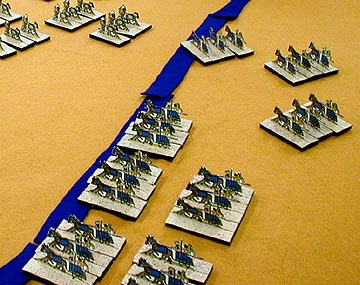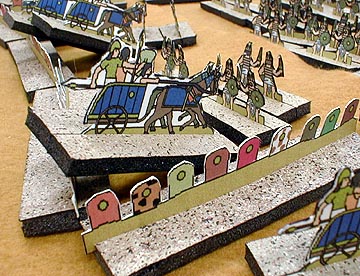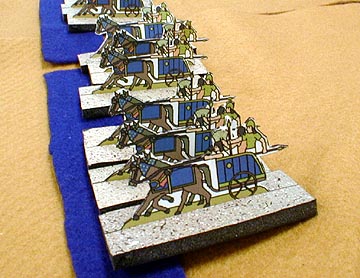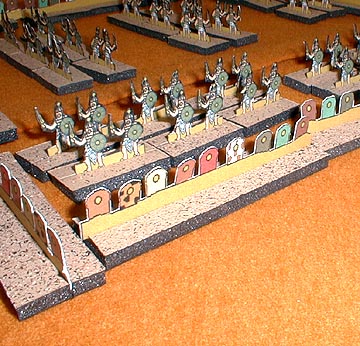 Fightin'
for the Pharaoh
Fightin'
for the PharaohFast Play Rules for the Battle of Kadesh (1300 BC)
 Fightin'
for the Pharaoh
Fightin'
for the Pharaoh
Historical Background: The chariot was an effective weapon
during the Bronze Age. In Egypt they favored a light, highly maneuverable
chariot from which the rider could fire arrows at the enemy. The
Hittites used a heavier chariot designed to drive into the enemy,
delivering a heavy blow at close quarters. The two empires came
into conflict over the rich lands of Syria, which lay between
their respective spheres of influence. Pharaoh Rameses II was
the first to arrive at the strategic city of Kadesh. He settled
into a fortified camp to await the arrival of the rest of his
army. Only he didn't arrive first. King Muwatallish was camped
near by, with his entire army. The Hittite king sent a strong force
of chariots to attack. They first encountered a corps of the Egyptian
army on the march, and scattered it. Next they moved to attack
the Egyptian camp. The Hittite chariots succeeded in invading
the camp, but the attack bogged down. The Pharaoh's Sherden bodyguards
defended the camp, and Rameses himself rallied his chariots and
counterattacked. They drove off the Hittites, and pursued them.
Then the Hittite King led another force of chariots to attack
the now lightly defended Egyptian camp. Egyptian reinforcements
arrived just in time to foil the attack. The battle was an Egyptian
victory, however a peace treaty between the two sides was soon
completed that gave control of the area to the Hittites.
 Battle 1: The Hittite advance
force immediately rushed to attack the Egyptian camp. The Pharaoh
and his chariots challenged them but were quickly swept from the
field. The Pharaoh took refuge in the camp where his Sherden guards
were putting up a strong defense. The Egyptian reinforcements
arrived just as the situation looked bleak. The Pharaoh sent messages
to the advancing Ne'arin ordering them to waste no time in coming
to his aid. They complied, rushing to save their leader. King
Muwatallish led his reinforcements across the Orontes, intent
on intercepting the Ne'arin.
Battle 1: The Hittite advance
force immediately rushed to attack the Egyptian camp. The Pharaoh
and his chariots challenged them but were quickly swept from the
field. The Pharaoh took refuge in the camp where his Sherden guards
were putting up a strong defense. The Egyptian reinforcements
arrived just as the situation looked bleak. The Pharaoh sent messages
to the advancing Ne'arin ordering them to waste no time in coming
to his aid. They complied, rushing to save their leader. King
Muwatallish led his reinforcements across the Orontes, intent
on intercepting the Ne'arin.
The Hittite reinforcements, with the King leading the way, rushed headlong into the advancing Egyptians and right into a trap. The King's men sacrificed themselves so their leader could escape. King Muwatallish rode out of the trap, cheating death as arrows rained down all around him. Meanwhile the Hittites overran the Egyptian camp, massacring the Sherden and looting the baggage while the Pharaoh fled for his life. He made it safely to the Ne'arin, but the Hittites controlled the field and claimed a narrow victory.
Battle 2: The Hittites quickly destroyed the small Egyptian chariot force, but the camp was a much tougher nut to crack. Under the inspirational leadership of the Pharaoh the Sherden defended the camp like lions. The Hittite attack stalled. They would need reinforcements to take the position. Fortunately there were more chariots on the way. King Muwatallish split his reinforcements, sending half of them to intercept the Ne'arin, and the other half to bolster the attack on the camp. Under increasing pressure, the Pharaoh abandoned the camp and took command of the Ne'arin. The Hittites crushed the Sherden and plundered the camp.
Outside the camp the Ne'arin gained the upper hand. The increasingly desperate Hittites concentrated on eliminating the Egyptian chariots. The tactic was effective, but the Egyptian infantry proved tougher than expected, and the Hittites began to crumble. Watching his army dissolve around him King Muwatallish had one last card to play. Riding forward he boldly challenged the Pharaoh to face him in personal combat. With his men watching, the Pharaoh dared not refuse. The chariots carrying the two great men raced towards one another. The Pharaoh fired his bow, missing badly. Roaring into close range the King's spear found its target, and the Pharaoh fell from his chariot with a mortal wound. The stunned Egyptian army abandoned the field. King Muwatallish had stolen a victory, while losing his army.
Rules
The Armies: Right now no company is producing 1/72 plastic figures suitable for this battle. Atlantic/Nexus made Egyptians which are good if you can find them. Caesar is planning to produce both Egyptians and Hittites. In the meantime here are some paper soldiers you can print and use. Foot figures are mounted two to a base, chariots are based individually. Base sizes were .75" x 1.5" for infantry, 2.5" x 1" for chariots. Foot units have six bases arranged in a double rank line. Chariots have three bases in a line.
|
Egyptians (Foot units have six bases, chariots have three bases) Defending Camp Reserve Force (Ne'arin) Enter
Turn 3 |
Hittites (all units have three bases) Advance Force Second Force Enter Turn 3 |
The Board: The terrain was flat and a 7.5 X 5 foot table was used. The Egytian camp and River Orontes must be modeled. The camp was surrounded by a shield wall, which seems to have been an earthen embankment topped by Egyptian shields. You can simply mark the location of the walls. The river could be drawn with marker, or represented by blue felt.

 Deployment: The Egyptian forces defending the camp
must deploy within the camp, or within 6" of the shield wall.
The Hittite Advance Force deploys as indicated on the map, not
closer than 12" from any Egyptian unit. The Egyptian Reserve
Force and Hittite Second Force enter on turn three as shown on
the map.
Deployment: The Egyptian forces defending the camp
must deploy within the camp, or within 6" of the shield wall.
The Hittite Advance Force deploys as indicated on the map, not
closer than 12" from any Egyptian unit. The Egyptian Reserve
Force and Hittite Second Force enter on turn three as shown on
the map.
Sequence of Play:
1. Egyptians Move
2. Egyptians Shoot
3. Hittites Move
4. Charge into Melee
5. Melee
Movement: All infantry units move 6", chariots move 12". Hittite chariots are limited to one 90 degree turn during their move. Egyptian chariots can make two 90 degree turns during their move.
Shooting: Only archers and Egyptian chariots (including the Pharaoh) are allowed to shoot. They have a range of 12". Roll 1D6 for each archer base or Egyptian chariot in range. Every 6 is a hit and one enemy base is removed. The Pharaoh hits on a 5 or 6. If any part of a unit is in range the entire unit may fire. Units that are engaged in melee may not fire, and may not be targeted.
Charge into Melee: Both sides may charge into melee. This is the only way to get into hand-to-hand fighting. Foot units may charge up to 6", chariots may charge 12". Units may only charge if they can reach an enemy unit in front of them. If it matters, Hittites charge first.
 Melee: Each side rolls 1D6 for each base in
the fight. The Melee Table shows the number needed to score hits.
Remove one enemy base for every hit. Both sides roll simultaneously.
If both units still have stands left they remain engaged and fight
again next turn.
Melee: Each side rolls 1D6 for each base in
the fight. The Melee Table shows the number needed to score hits.
Remove one enemy base for every hit. Both sides roll simultaneously.
If both units still have stands left they remain engaged and fight
again next turn.
Last Stand: When a unit is reduced to a single base the last base is immediately removed.
Leaders: The King and Pharaoh may not be targeted individually. If they are attached to a unit they count as an extra base in melee. If the unit they are attached to loses bases in melee roll 1D6. If the roll is a 6 then the leader is eliminated.
The Egyptian Camp: The Egyptian camp was a difficult place for chariots to fight, and the lure of plunder distracted the Hittite attackers. Chariots fighting a melee against an enemy in the camp have their hit number reduced by one - Egyptians chariots would hit on a 6, Hittite chariots would hit on a 5 or 6.
Chariot bases: Each chariot base is counted as two bases when shooting, fighting in melee, and removing casualties. When a chariot unit suffers a single casualty this is represented by turning one base backwards. The backwards base then counts as a single base.
Flank Attacks: Units that charge an enemy unit on the flank or rear gain an advantage. The flanked unit may only fight back with two bases. This advantage applies only on the first turn of melee.
Crossing the River: A unit crossing the river must end its move with the front rank of the unit in the middle of the river. This unit may not charge during this turn, and if charged by the enemy it may not fight back. These restrictions only apply during the turn they enter the river. On the next turn they may move and fight normally.
|
|
Resources